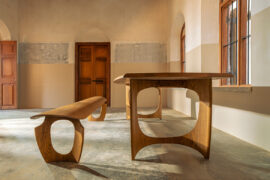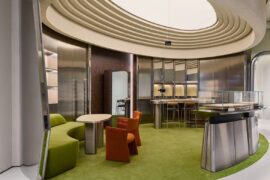What will The Work Space category of INDE.Awards reveal to us in 2022? Last year it shone a light on the changing standard of workspaces and commercial design. Here’s what past shortlisters and category partner, Herman Miller, have to share.

Market Lane, by Elenberg Fraser. Image by Damien Kook
March 29th, 2022
By now, we are all aware of the changes in working environments. Flexible, hybrid workspaces and the facilitation of remote working have become normative in companies the world over, with these top-level changes kickstarting flow-on effects to everything from residential to civic architecture.
And yet, we must question whether the pandemic has merely intensified a shift that was already happening? A reckoning that was already bubbling away, where the notion of productivity was seeing a shift away from the traditional corporate workplace and into something more personal, considered and adaptable.

Since the inception of the INDE.Awards some six years ago, its annual The Work Space shortlist has acted as a barometer for this change, where the top 12 workplaces in the Indo-Pacific have demonstrated an approach by employers and architects alike which put the working experience front and centre.
We’ve seen workplaces in homes and in gardens, expansive, moody offices and smaller ones flooded with natural light.
Perhaps what we see most of all is a reflection on styles and systems of working, where there is a rising consideration of comfort and amenities, places where architecture, materiality and furnishings are innately correlated to new ideas of productivity, health and wellbeing.

For 2022 category partner Herman Miller, the changing nature of workplaces is one that they are highly familiar with, as their leading collection of workplace furniture solutions are featured in many of the world’s leading workplace designs.
“Herman Miller is a globally recognised leader in design,” says Mike Radda, area vice president North Asia and Pacific for MillerKnoll. “Since its inception in 1905, the company’s innovative, problem-solving designs and furnishings have inspired the best in people. Herman Miller is guided by an enduring legacy of design, innovation, and social good. In 2021, Herman Miller and Knoll created MillerKnoll, a collective of dynamic brands that comes together to design the world we live in.”
“Since the beginning, Herman Miller has always considered how workplace design evolves. This is evident with their new OE1 Workspace Collection. Launched last year, the collection contains optimised essential pieces that support the post-pandemic workplace. What is so fascinating is that the research that supported the collection’s development took two years to complete and was executed well before the pandemic began. It’s almost like Herman Miller predicted the future,” notes Radda.

As we look back on the past shortlists from the Work Space category, we see designs that are less based in “trends” but are instead bespoke pieces that reflect the working style of the companies they are designed for.
In 2021 alone, we had a scale that stretched from the mixed use office/home setups of both Alexander &CO and Smart Design Studio’s main design outposts, where the studios’ talent and aesthetic were put on show, to the expansive, multi-level financial hubs of NAB 3 Parramatta Square (Woods Bagot, Australia) and The Foundry – CBA @ South Eveleigh (Davenport Campbell & Partners with fjmtstudio, Australia).
At the headquarters of Cotton On Wellness, Greg Natale Design and PTID offered a chalet-style holistic workspace, while Elenberg Fraser and Contrast Design put on a colourful, expressive display at Market Lane and WPP CAMPUS – BAY 99 respectively.

For Alexander & CO., the creation of Alexander House is a thesis, prototype and a place for the team and community to test out and challenge ideas, as well as a space to host creative conversations and events. Their model is on the top end of a shift towards workplaces that are led by design, smaller, mixed-use and co-working environments where every design decision is an extension of a brand and its culture, where employees are made to feel part of the family as they work from a space that draws more heavily from residential design vernaculars than those more typical of corporate designs.
Like all design work, designing a workspace like Alexander House took immeasurable time, dream filled nights and many wonderful discussions about what could be that we hadn’t already considered,” noted Alexander &CO. Principal Jeremy Bull.
“Like all evolutions I suspect that change will oscillate in and out, workspaces will cater to the specifics of the firms that inhabit them, and no one size will fit all. We haven’t really changed much as a species whilst our work practices have changed enormously.”

Looking at this on a larger scale, WPP CAMPUS, designed by Contrast Design, is an example of the first community-based workplace in India. Occupying a 35,000 square meter space and housing 3500 employees, the building is spread across nine floors, where flexible and interchangeable spaces were designed for 18 top advertising and media sister agencies to be brought into one main space.
The design is agile and activity-based, set out to provide opportunities for building a holistic company culture without compromising on each individual group’s unique approach to work.
For this year’s program, the 2022 INDE.Awards jury will consider a range of elements such as originality and quality of design, the performance of the concept, sustainability principles and initiatives as well as innovation.
Consideration is given to form and space materiality and technology but also to meeting a client brief and providing a design that is sympathetic to site and locality.

Category partner Herman Miller says of this year’s shortlist, “I expect we will see innovative and forward-thinking design that challenges what we traditionally expect to see from workplace designers.”
As we all know the work space is as much a social and cultural place as a setting for function and facility. Now more than ever, a project in The Work Space category is judged as much for the ability to connect people as the interior and architectural creative design, as we navigate a shifting global response to how we work.
.
Entries to the 2022 INDE.Awards close on 31/03/2022 at 23:59 AEDT. Entries can be started, modified and submitted here and should be entered according to the Awards’ category criteria.
The Work Space category is proudly partnered by Herman Miller.
INDESIGN is on instagram
Follow @indesignlive
A searchable and comprehensive guide for specifying leading products and their suppliers
Keep up to date with the latest and greatest from our industry BFF's!

London-based design duo Raw Edges have joined forces with Established & Sons and Tongue & Groove to introduce Wall to Wall – a hand-stained, “living collection” that transforms parquet flooring into a canvas of colour, pattern, and possibility.

Rising above the new Sydney Metro Gadigal Station on Pitt Street, Investa’s Parkline Place is redefining the office property aesthetic.

Architect, designer and craftsman Adam Markowitz bridges the worlds of architecture and fine furniture, blending precision, generosity and advocacy to strengthen Australia’s craft and design community.

Inside Bangkok’s Siam Paragon Mall, L’Atelier by Dinding Design Office celebrates the artistry of independent watchmaking through a space defined by light, craft and meticulous detail.
The internet never sleeps! Here's the stuff you might have missed

Several design groups are coming together on 29th October, 2025 for ‘grounded,’ a day of talks and workshops on Country-centred design.

BVN’s Sirius Redevelopment has been named one of two joint winners of The Building category at the INDE.Awards 2025. Celebrated alongside Central Station by Woods Bagot and John McAslan + Partners, the project reimagines an iconic Brutalist landmark through a design approach that retains heritage while creating a vibrant, sustainable future for Sydney.